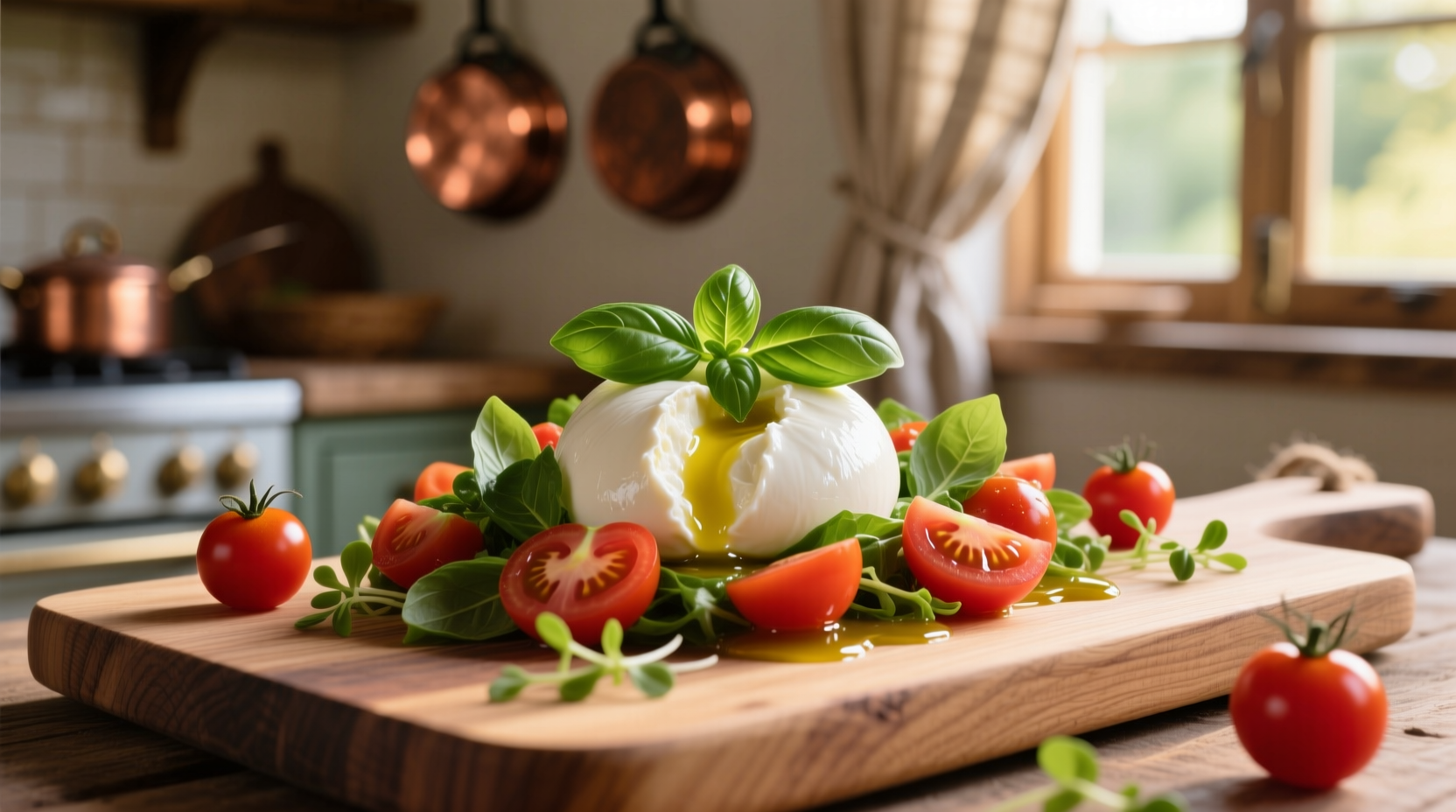Nothing captures summer's essence better than a perfectly executed burrata salad with tomatoes. This Italian-inspired dish combines the luxurious creaminess of fresh burrata cheese with the bright acidity of vine-ripened tomatoes, creating a flavor harmony that's both simple and sophisticated. When prepared correctly, this salad delivers an unforgettable culinary experience that elevates everyday ingredients to extraordinary heights.
Why This Classic Combination Works
Burrata's unique texture—soft mozzarella exterior surrounding a creamy stracciatella center—creates the ideal canvas for juicy tomatoes. The cheese's mild dairy notes complement rather than overpower the tomatoes' natural sweetness, while the acidity in quality tomatoes cuts through the richness. Food science confirms this pairing follows fundamental flavor pairing principles: complementary fat-acid balance enhances overall taste perception.
| Tomato Variety | Best For | Flavor Profile |
|---|---|---|
| Heirloom | Visual presentation | Complex, sweet-tart balance |
| Cherry | Quick preparation | Concentrated sweetness |
| Beefsteak | Slicing presentation | Meaty texture, mild acidity |
| Roma | Structured salads | Firm texture, lower moisture |
Essential Ingredients Checklist
Selecting premium components makes the difference between ordinary and exceptional. For authentic results:
- Burrata: Seek fresh, locally made cheese with production date within 48 hours. Authentic burrata should feel heavy for its size with no liquid leakage.
- Tomatoes: Choose vine-ripened varieties at peak season. Heirlooms offer complex flavors while cherry tomatoes provide consistent sweetness year-round.
- Olive oil: Use unfiltered, cold-pressed extra virgin with peppery finish (California or Ligurian preferred).
- Basil: Genovese variety provides the classic sweet-anise notes that complement dairy beautifully.
Step-by-Step Preparation Guide
Follow these professional techniques for perfect results every time:
- Temperature management: Remove burrata from refrigerator 20 minutes before serving. Cold cheese masks flavor and texture.
- Tomato preparation: Slice tomatoes ¼-inch thick and arrange on chilled plate. Sprinkle lightly with flaky sea salt to draw out juices.
- Burrata handling: Gently tear open the pouch just before serving. Never cut burrata with knife—use hands to maintain structure.
- Assembly sequence: Place cheese centerpiece, surround with tomatoes, then drizzle with oil. Finish with torn basil leaves and freshly cracked pepper.

Avoid These Common Mistakes
Even experienced cooks make these critical errors:
- Over-dressing: Excessive oil overwhelms delicate cheese. Use 1-2 teaspoons per serving.
- Early assembly: Placing cheese on tomatoes too soon causes sogginess. Assemble immediately before serving.
- Wrong vinegar: Balsamic competes with burrata's flavor. Opt for sherry vinegar or omit entirely.
- Poor knife skills: Cutting burrata destroys its signature creamy center. Always tear by hand.
Seasonal Variations and Pairings
Adapt this classic recipe throughout the year while maintaining integrity:
- Summer peak: Add fresh watermelon cubes and mint for a refreshing twist
- Fall version: Incorporate roasted peaches and toasted pine nuts
- Winter adaptation: Use slow-roasted tomatoes and truffle oil sparingly
- Wine pairing: Light-bodied Pinot Grigio or dry Rosé complements without overwhelming
Food Safety and Storage Guidelines
Fresh burrata requires careful handling due to its high moisture content:
- Consume within 24 hours of opening packaging
- Never leave assembled salad at room temperature超过2 hours
- Store unopened burrata in original liquid at 34-38°F (1-3°C)
- Do not freeze—texture becomes grainy and separates
According to FDA food safety guidelines, fresh cheeses like burrata fall under the category of potentially hazardous foods requiring strict temperature control. The FDA Food Code 2022 specifies that dairy products should be maintained below 41°F (5°C) to prevent bacterial growth.
Historical Context of Burrata
Burrata's story reveals why this preparation method creates superior texture:
- 1920s: Created in Puglia, Italy as a way to use cheese scraps
- 1950s: Traditional production methods standardized across southern Italy
- 2000s: Gained international recognition through Slow Food movement
- Present: Protected under European Union's Traditional Speciality Guaranteed (TSG) designation
This evolution explains why authentic burrata maintains specific textural qualities that mass-produced versions often lack. The traditional method of encasing stracciatella and cream in mozzarella pouch creates the signature burst of richness that defines the experience.
Perfect Pairing Principles
Understanding flavor chemistry elevates your preparation:
- Fat-acid balance: Tomatoes' natural acidity cuts through burrata's richness
- Texture contrast: Creamy cheese against juicy tomatoes creates satisfying mouthfeel
- Temperature play: Slightly chilled components enhance freshness perception
- Seasonal harmony: Peak-season ingredients naturally complement each other
Professional chefs follow these principles to create dishes where components enhance rather than compete. The ideal burrata salad should showcase each ingredient's strengths through thoughtful combination.
When This Salad Shines (And When to Choose Alternatives)
Understanding context boundaries ensures perfect dish selection:
- Ideal for: Summer entertaining, light lunches, appetizer courses, vegetarian menus
- Less suitable: Cold weather months (unless using roasted tomatoes), formal dinner mains, large buffet settings
- Alternative when: Ingredients aren't peak-season quality or when serving large groups (consider caprese salad instead)
Recognizing these boundaries prevents disappointment when ingredients aren't at their best. The dish's simplicity means quality components are non-negotiable for success.
Final Pro Tips for Perfection
Implement these professional techniques for restaurant-quality results:
- Chill plates for 15 minutes before assembly to maintain ideal serving temperature
- Use finishing salt like Maldon for texture contrast against creamy cheese
- Add oil in circular motion starting from center to distribute evenly
- Serve with crusty bread for soaking up delicious juices
- Prepare all components in advance but assemble immediately before serving











 浙公网安备
33010002000092号
浙公网安备
33010002000092号 浙B2-20120091-4
浙B2-20120091-4